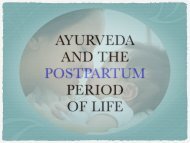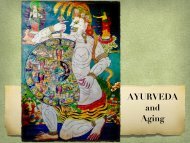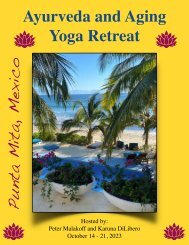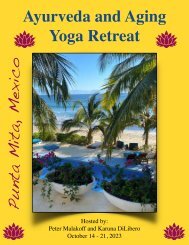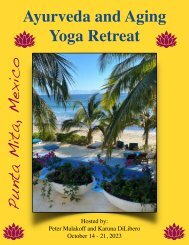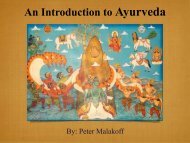Ayurveda and Aging Namaste 2023
This is a more condensed version of my Keynote presentation on Ayurveda and Aging. It was given on October 30, 2023 in Ajijic, Mexico at Namaste Village.
This is a more condensed version of my Keynote presentation on Ayurveda and Aging. It was given on October 30, 2023 in Ajijic, Mexico at Namaste Village.
You also want an ePaper? Increase the reach of your titles
YUMPU automatically turns print PDFs into web optimized ePapers that Google loves.
AYURVEDA
and
Aging
In 2004, I received a degree in Ayurveda from
Kalidas Sanskrit University in India.
The very first instruction I received in the
formal welcome to the school was:
‘Everything in the world is medicinal, and
everything in the world is poisonous.
‘Ayurveda will teach you how to tell the
DIFFERENCE between the two.’
In this presentation, we will
explore these various
‘Differences’
After graduation, I visited Benaras, the oldest
still-living city in the world. There, I heard a story
about Kabir, one of the greatest saints of medieval
India. It went like this:
The king of Benares had built a large palace on
the banks of the Ganges river and wanted Kabir
to come and visit his palace. Kabir accepted, and
after a tour of the palace, the King asked him
what he thought of the place.
Kabir replied,
‘There are two defects which cannot be fixed,’
‘Tell me what they are, and I shall fix them right away,’ said
the King.
‘You cannot do it,’ replied Kabir.
‘Why not? I have the money and men. Tell me what they
are and I shall have them fixed,’ said the king
Kabir then said:
‘One is that this palace will grow old and decay.
The second is that you will grow old and die.’
Our consideration is suggested by
Kabir’s -‘Grow old and die’:
This brings us to
AYURVEDA and Aging
So let’s begin with a consideration of
AYURVEDA
Ayurveda is the
‘Veda’ ‘(Science)
of
‘Ayu’ (Life)
Ayurveda
is taught on
earth so
mankind can
enjoy a long
and healthy
lifespan
Ayurveda contains
the Vidya or knowledge
of ‘how to create or maintain
the health of the healthy
and cure or palliate the disease
of a diseased person’
From the Yoga Sutras,
Ayurveda draws a fundamental
principle regarding the Law of Karma:
‘Heyam Dukham Anagatam’
- Patanjali Yoga Sutras 2:16
‘The suffering that has not yet come
can be avoided’
The suffering
that is here,
is here because of ‘karmic’
reasons . . .
it has past cause or causes
and must be endured
But, the suffering
that is not yet here can be avoided,
by changing our actions
Ayurveda says:
with proper understanding
we may move towards health
by means of right actions
There is a causative factor for the
manifestation of a bodily being, but
there is
no cause for the cessation of
this manifestation since death
following birth is the natural flow of
life itself
- Charaka Samhita
Suffering born of Time (Aging) is
inherent in life and cannot be
avoided, but only palliated.
This is a foundational principle
of
Ayurveda and Aging
KALA
(Time)
Life is held in the hands
of
Time or Kala
and Time is a fundamental
consideration
when we consider:
Aging
In Ayurveda,
Old Age and Aging is a
‘disease’ brought about by
Time
It is written in the Ayurvedic
texts:
‘Shiryate Iti Shariram’
‘The body is constantly
decaying’
We know everyone
who has taken birth
must grow old and die,
but no one wants to grow old
and no one wants to die.
But even from conception the
body is tending towards death
According to Buddha:
Birth, Disease, Old Age, and
Death comprise the inevitable
suffering
of a human being
“. . . birth is suffering, Old Age is
suffering, illness is suffering, union
with unpleasant things is suffering,
separation from pleasant things is
suffering, not obtaining what we wish
is suffering; all clinging to existence is
suffering”
- Buddha
Buddha was asked,
‘How are you different than other
men?’
He replied:
‘I was disturbed by
Birth, Disease, Old Age and Death,
others did not seem to be so disturbed’
In Ayurveda,
any state that is not pleasurable
is called - ‘Disease’
In Tibetan medicine,
(which arose from Ayurveda),
life itself is a disease that ends in death
Ayurveda considers Aging
Born of time
as
a ‘Natural’, and
only Palliatible
disease
‘Palliative’ here refers to:
Treatment that affirms life and
regards ‘Aging,’ and death as a
natural and normal process
Palliative Care provides relief
from unnecessary pain or
distressing symptoms
Even though Buddha said:
‘Suffering is inevitable’
he also said that:
‘All suffering is not necessary’
The ‘disease’ of Aging is
inevitable,
But, it may be manifested in a
timely or untimely,
comfortable or uncomfortable,
disease-free or disease-filled,
manner
The Ayurvedic approach to Aging:
is to remedy and/or palliate
the
underlying imbalances
brought about by Aging
Even though,
Time or Kala creates an
unavoidable imbalances in the
body
Ayurveda teaches us how to
palliate those ‘unavoidable’
imbalances
According to Ayurveda-
The growth, development,
maintenance and decay
of the body
are dependent on
four factors or qualities:
1) Kala (time)
2) Swabhava
(nature, doshic make up)
3) Ahar (Diet)
4) Paryavarana -Environmental
factors
The first two:
1) Kala (Time)
2) Swabhava
(nature, doshic make up)
We Cannot Control
but only Palliate
The second two:
3) Ahar (Diet)
4) Environmental factors
We Can Control
Diet (Ahar) and Environment)
can be controlled
AYURVEDA PROVIDES THE
WISDOM OF HOW TO DO SO
according to:
Kala - Time (impersonal)
and Svabhava- Self Nature (personal)
LET’S
LOOK AT EACH OF THESE FOUR FACTORS
STARTING WITH TIME
Kala or Time holds
a human being
in its grasp
from birth until death
So fundamental is Kala or
time that an image of Kala
holding the wheel of life is
painted directly next to the
main entry of every Tibetan
Buddhist monastery
Greed
Anger
Ignorance
Delusion
The ‘Three Poisons’ of life
It is called:
the ‘Bhavachakra’
or the
The Wheel of Becoming
or
The Wheel of Life
It is Kala or Time that creates:
• The Yugas
• The seasons of a year
• The hours of day and night
• The seasons of a person’s life
• Aging
Buddha spoke of Time
as the context,
of inescapable suffering
. . . for it is Time that
determines our inability to gain
any permanent happiness in
life,
no matter what our actions are
Just as we need to understand the
place where we live
the season of the year
and the time of the day
Ayurveda says it is necessary to
understand
\
the Season or Time
of our life
The effect of Time on the body
is Kshaya or the diminishing of
all the capabilities of the bodymind
with Old Age
Let’s look more closely
at how Kala or Time
is expressed
in the ‘Stages of Life’
The Stages of Life
The Chandogya Upanishad says
that a man or woman enjoys 116
years of life
Balavastya: +/- 24 years
Yuvavastha: +/- 44yrs (24-68)
Vrddhavastha: +/- 48 yrs (108-116)
Balavastya (Youth)
From conception to a girl’s first period
(approximately 14-16 years of age; now
earlier) is the time that Kapha or the
EARTH and WATER elements rules.
This period exhibits a steady increase
and coordination of the strength and
integrity of the body, mind and senses
Madhyavasta (Middle Age)
The FIRE element rule middle age and
lasts (approximately) from 14-16 years to
60-70 years of age. It is dominated by
PITTA DOSHA. There is an increase of
hormonal activity, the digestive abilities
of food and experience; full engagement
of the senses, mind, intellect and a
greater (or lesser) mastery of will
Vriddhavastha (Old Age)
This is the period from 70 years to
our death, when there is everincreasing
wasting or decay
(Kshaya) in the body. This time of
life correlates
with Vata Dosha or the Air and
Ether elements
As we age there is a natural decrease
of the Dhatus or bodily tissues:
There is wrinkling of the skin, graying
of the hair, baldness, diminished
ability to do physical work, diminished
digestive power (JatharAgni) and
diminished immunity (Ojas)
In Old Age
(even if one is not sick or in pain)
there is a decrease in the
(sensory organs)
There is diminishing strength,
speech, mental and cognitive
functions, memory, intellect and
analytic ability
When these symptoms come
about in accord with a
balanced or healthy
Swabhava (self-nature),
it is known as
Natural Aging
When Aging results from a result
of a defective diet and lifestyle,
Vriddhavastha (Old Age) begins
earlier and is then known as
Akalaja Vriddhavastha
or (untimely Aging) and is usually
accompanied by disease
Worry, Anxiety, Smoking increase
Aging in any individual
Aging can be slowed and
‘Untimely Aging’ is preventable.
Even if symptoms of untimely
Aging are already manifested,
they can be managed or
palliated by applying the
principles of Ayurveda
One of the well-known principles of
Ayurveda is:
‘Like increases Like
Opposites decrease one another’
The words for ‘Health’ in Ayurveda
is Svastha, Sama or balance. Balance
is the working principle of Ayurveda
According to Ayurveda, the
‘patho’-physiology of Aging is
caused primarily by diet and the
process of Aging can be slowed
down by correcting and
balancing
the diet and lifestyle
SVABHAVA
or
Self nature
So, the first factor is TIME-KALA
The second of the four factors,
(Kala, Svabhava, Diet,
Environment)
that creates the growth, development,
maintenance and decay of the body
is‘Svabhava’
- the unique, individual nature, or
elemental makeup of our body
For most people in the West today
who have gained a little knowledge of
Ayurveda, this elemental makeup of
the body is called -
‘Svabhava,’
which is another name for
Dosha
To balance Svabhava it is
necessary to understand the
‘5 elements,’ as each of our
bodies is composed of
differing combinations of
what are called the
5 elements or the
Panchamahabhutas
We must understand and determine
our Dosha
so we can balance it
When we understand our environment
in terms of the five elements, we can
begin to understand its Doshic Effect
These five elements are:
Ether (Akash)
Air (Vayu)
Fire (Agni or Tejas)
Water ( Jala)
Earth (Bhumi)
The Five Elements
Panchamahabhutas
Everything in creation is made
of
differing combinations of
the 5 elements
(always and only
all-together appearing)
They are called the
Panchamahabhutas
When the
Panchamahabhutas are
considered in terms of location
they are called: the Environment:
desert, ocean, forest, mountain,
cold, hot, windy, dry
When the
Panchamahabhutas are
considered in terms of Food
they are called- The Six tastes:
sweet, sour, salty, bitter,
pungent, astringent
When the
Panchamahabhutas are
considered in terms of the
Seasons of the year, they are
called:
spring, summer, fall, winter
When the
Panchamahabhutas are
considered in terms of the
Time of the day, they are
called: dawn, morning,
afternoon, evening and
nighttime
When the
Panchamahabhutas are
considered in terms of the
Seasons of a persons life, they
are called: childhood,
adolescence, middle age and
Old Age
When the
Panchamahabhutas are
considered in terms of the
Ages of the Universe they are
called the Yugas:
Kali, Dwarpa, Treta and Sat
When the Panchamahabhutas
are considered in terms of the
human body they are called:
Doshas
When Ayurveda traveled to the
West through Persia and then
Greece, these Doshas were
called the Humors
Hippocrates
Galen
Doshas
Panchamahabhutas
and
Dosha
“Neither in theory nor in fact is
there a physical manifestation
that cannot be accounted for
by the concept of Tridosha”
– Charaka Samhita
The ‘Nature’ or quality
of a thing
(or one’s body)
is called:
DOSHA
or
SVABHAVA
When we consider
an individual being
and his or her unique combination
of the elements
the particular element (or
elements)
that predominates amongst them
is called their Dosha
DOSHA
(Also) Means ‘that which vitiates,
aggravates, darkens, spoils
or
causes things to decay’
There are
Varying combinations of the
Panchamahabhutas or
5 Elements that determine the
Dosha
Vata, Pita and Kapha
are the 3 Doshas
Let’s look at some examples of
Dosha and how differing
combinations of the elements
determine different types of
the human body-mind:
Everything contains all of the
five elements together. When we
speak about Dosha, we are
referring to the predominance
of certain elements.
KAPHA
Earth and Water predominant
KAPHA
KAPHA
PITTA
Fire and Water predominant
PITTA
PITTA
Vata
Air and Ether predominant
Vata
Kapha and Vata
‘Yatha Loka Tatha Pindam’
(As is the whole world, so is the body)
The physical and psychological human being
follows the pattern of a full day of the world
Kapha in the morning hours (6-10am)
Pitta in the midday hours (10-2pm)
Vata in the late afternoon hours (2-6pm)
Kapha rules the morning hours (6-10am)
Diseases of a Kapha type mainly happen
to a person in their Kapha season of life
and their symptoms express most
powerfully during the Kapha hours
Pitta rules the midday hours (10-2pm)
Adolescence-Midlife (14-60yrs)
Middle age people are primarily affected
by Pitta disorders and these symptoms often
heighten during the Pitta hours of the day and
years of life
Vata rules the afternoon hours of the day (2-6pm)
and the later years of life (70- death)
Elderly people are primarily affected
by Vata disorders and these symptoms
often heighten during the Vata hours of
the day and years of life
The 5 Elements or
Panchamahabhutas express
themselves
in every aspect of life
Under the
Controlling Effect
of Time,
Each stage of life, expresses
different Panchamahabhutas
or Doshas
Now we have the
background to consider
Aging
for
Old Age is the time of Vata
Old Age
The Time
of
Vata
Like Air and Ether
Vata
is easily shaped and
affected by
the environment
Vata is the ‘environment,’ time or
season of Old Age
Vata rules Old Age
Therefore,
We must Recognize, Understand and
Balance the increase of Vata
in our diet and lifestyle,
to maintain or create balance
in our Old Age
Interestingly, our modern day
environment is more Vata than ever in
history.
We move faster,
do more, process our foods and drinks
use modern medicine to suppress our
disease symptoms, spend
more time in front of computers and TV
movies ‘move’ faster
girls get their periods at a younger age
What are the qualities or
‘Gunas’ of Vata
according to Ayurveda?
Vata is:
Cold
Dry
Light
Irregular
Rough
Moving
Quick
Changeable
Sharp
The working Principle of how to achieve
‘Balance’ or Sama in Ayurveda is:
“Similars increase one another
Opposites decrease one another”
So, to balance Vata
we need:
Cold-
Light -
Dry -
Irregular -
Rough -
Quick-
Mobile-
Subtle-
Warm/hot
Heavy
Oily/ moist
Regularity
Smooth
Slow
Steady
Touch
When Vata Dosha is out of
balance there is an excess of the
qualities that define that Dosha
For instance:
For Instance:
Light: The person loses weight
Cold: The person feels chilled
Dry: The skin, lips, mucosal glands become dry
Mobile: the voice becomes too quick or rambles
Subtle: The person is easily affected by the feelings of
others
Hard: the stools become hard and difficult to eliminate
Irregular: Easy to change
Rough: The skin becomes rough
Look at how Vata
characteristics are similar to
the effects of Old Age:
Ayurveda looks at the following
as a consequence of Aging:
Dhatu Kshaya- degeneration of tissues
Indriya Kshaya- degeneration of senses
Bala Kshaya- loss of strength
Utsakhakshaya- loss of motivation
Viryakshaya- decreased libido
Vali- wrinkles
Palithya- greying of hair
Khalithya- baldness
Ayurveda offers the knowledge of how to
bring
Vata Dosha into balance.
The principle
to achieve Balance
is: by increasing the opposite
qualities of whatever elements or
Doshic effects are in predominance:
Change can be made in
everything
Daily Routine, Sleep, Sex,
Diet, Herbal supplements,
colors, aromas, massage, oils
and overall lifestyle . . .
Through adopting an
appropriate Diet and Lifestyle
we can bring
Vata Dosha into balance
Like every other Dosha, people
who have high Vata have been
given both a blessing and a curse.
The Blessing is that it is ‘easy for
them to change’; the Curse is that
it is ‘easy for them to change.’
Whatever is done must be
done regularly!
Vata tends to be irregular,
and irregularity only increases
Vata Dosha
Here is more of what
Ayurveda
says about
Vata Dosha:
Physical Characteristics:
Those with a predominance of Vata dosha
usually have a thin, light frame and
excellent agility. Their energy comes in
bursts and they are likely to experience
sudden bouts of fatigue. Vatas typically have
dry skin and hair and cold hands and feet.
They sleep lightly and their digestion can
be sensitive. When the Vata dosha becomes
imbalanced, it manifests in the body as
weight loss, constipation, hypertension,
arthritis, weakness, restlessness, and
digestive challenges.
Emotional Characteristics:
Vatas love excitement and new
experiences. They are quick to anger but
also to forgive. When Vatas are in balance,
they are energetic, creative, and flexible.
They also take initiative and are lively
conversationalists. When unbalanced, they
are prone to worry and anxiousness and
often suffer from insomnia. When they feel
overwhelmed or stressed, their response is,
“What did I do wrong?”
If excessive stress in your life makes your
Vata imbalanced, your activity will start to
feel out of control. Your mind may race,
contributing to anxiety and insomnia. You
may start skipping meals, resulting in
unintended weight loss, and your digestion
may become irregular. If you notice these
‘early’ symptoms of a Vata imbalance, slow
down, take time to meditate, don’t skip
meals, and get to bed earlier. A regular
lifestyle routine helps ground Vata so you’re
not carried away into the ether
Vata Pacifying Diet
Vata is balanced by a diet of freshly cooked,
whole foods that are soft or mushy in texture,
rich in protein and fat, seasoned with various
warming spices, and served warm or hot.
These foods calm Vata by lubricating and
nourishing the tissues, preserving moisture,
and maintaining warmth while supporting
proper digestion and elimination.
Qualities to Favor and Avoid
Vata is cool, dry, rough and light, so eating
foods that neutralize these qualities – foods
that are warm, moist, oily, smooth, and
nourishing – can help to balance excess Vata.
An improved understanding of these qualities
can guide you in making specific dietary
choices that will better support Vata.
There are six tastes
Tastes to emphasize for
VATA:
Sweet (earth and water)
Sour (earth and fire)
Salty (fire and water)
Tastes to Decrease for VATA:
Bitter (Air and Ether)
Pungent (Air and Fire)
Astringent (Air and Earth)
It is best to have all six tastes
at every meal
Just in different proportions
for each Dosha
(Churnas)
Vata Churna
Thali
Stay Warm
Don’t get chilled
Avoid Drafts and Wind
Root vegetables and winter squash
will help nourish and balance the
body. Try carrots, beets, sweet
potatoes, pumpkin, acorn, butternut,
delicata, and buttercup squashes.
These have the qualities of sweet,
heavy, smooth, dense, and moist and
are most balancing for Vata.
Casseroles
Soups (Mung Dal)
Stews
Grains
Sweet grains such as Basmati rice,
wheat berries, brown rice, and sushi
rice. Also, whole wheat pasta and or
buckwheat udon noodles can be
especially grounding for Vata. Always
include Ghee and other healthful oils
such as almond, sesame, or sunflower
for internal oleation, kindling Agni,
and increasing absorption.
Spices
When preparing food, use
warming spices such as black
pepper, dry ginger, cinnamon
and asafoetida to help to stoke
the digestive fire.
Lunch
should be the largest meal of
the day
Sleep
Go to bed earlier
Time of Day and Dosha
Drink Hot Ginger Tea
Fennel
Licorice
Vata Tea
Very little Raw Foods
No cold drinks
No caffeinated drinks
No snack bars
No Granola
No Dried Fruits
OILS
All Good Fats
Ghee
Sesame oil
Sunflower
Herbs
Ashwagandha
Vata Digest Tablets from
Banyan Botanicals
Vata Churna from MAPI
Haritaki/ Amalaki - best herbs for
balancing Vata
Daily Abhyanga or Oil Massage
Coconut oil in hot climates
Sesame oil in cooler climates
Meditation
Transcendental
Meditation
Sitting Quietly
‘As we age, exercise must become
more gentle, easeful and
restorative and that’s the more
classical approach to the asana.
Asanas should exercise the body
sufficiently, but need not train
the body athletically.’
- David Frawley, -Yoga and Ayurveda
Yoga Asana
Do any and all asanas
smoothly and lightly
Pranayama
Nadi Shuddhi
Sleep
Hot Milk with Ginger, Cinnamon
Cardamom and Saffron
before bed
Panchakarma
Eliminate toxins and toxic conditions from your
body and mind.
Strengthen your immune system and become
more resistant to illness.
Reverse the negative effects of stress on your
body and mind, thereby slowing the aging
process.
Bring about deep relaxation and a sense of wellbeing.
Panchakarma (five actions) is a cleansing and
rejuvenating program for the body, mind, and
consciousness
Panchakarma is done individually for each
person with their specific constitution and
specific disorder in mind, thus it
requires close observation and supervision.
Treatment starts with pre-purification Measures
of Snehan (internal oleation) and Svedana
(external elation), and then cleansing methods –
Shodanas are applied.
PINDA SWEDA: Reduces Stress
The therapeutic properties of the oil on targeted pressure points,
drastically reduces stress.
Cures Insomnia
Pinda Sweda is an effective cure for people struggling with insomnia
and induces good sleep.
Manages pain and inflammation
Relieves pain and inflammation in problem areas, increases blood flow
and rejuvenates the system.
Soothes Nerves & Joints
The massage has soothing properties on the nerves and joints,
relaxing and rejuvenating them.
Detoxes
Removes metabolic wastes from the body,
hence acting as a mini detox treatment.
Heals Injuries
Heals age-related musculoskeletal problems and injuries naturally.
Swedana (external application of medicated oils)
Ayurvedic Spa at Villa Ananda, Punta Mita
Swedana (external application of oil)
Swedana - Steam Bath
Ayurveda Treatment Room at Villa Ananda
Pinda Sweda (Medicated/ heated herbal treatment)
Pinda Sweda
Basti (Lower Back)
Basti (neck)
Basti (Knees)
Basti (Heart)
Nasya (Nasal Medicated Oil Treatment)
Shirodhara
Rasayana
The way of Rejuvenation
Rasayanas
An 11th century Persian chemist and physician
named Abu Rayhan Biruni reported about
India:
“They have a science similar to alchemy which
is quite peculiar to them. They call it
Rasayana. It means an art that is comprised of
certain actions, herbs and compounds, most of
which are taken from plants. It restores the
health of those who were ill beyond hope and
gives back youth to those fading in Old Age.”
Rasayanas are herbal and mineral compounds
which according to Vedic texts help to:
- Maintain the original orderliness
of the physiology
- Preserve youthfulness and slow down
or reverse the Aging process
- Strengthen the immune system
- Make the body-mind more resistant
to damaging influences
Chyvana Rishi
and
Chyvanaprash
Chyvanaprash
Amalaki
“Of all Rasayanas, Amalaki is revered as
one of the most potent and nourishing.
“Amalaki is the best amongst
rejuvenating herbs.”
- Charaka Samhita
It was said by one of my
Teachers that of all the
Rasayanas, the very best is
to have
a purpose in life that you
are devoted to
‘Rasayana’ refers not merely to a
herbal regimen (drug) or a
therapy although both may be
included.
It is a ‘lifestyle’ that can be
undertaken by anyone
Rasayana is for maintaining the
health of healthy individuals, as
well as restoring the health of
diseased individuals
Rasayana prolongs longevity,
develops good health,
improves mental faculties, and
provides immunity against
disease
There is a particular Rasayana
called
‘Kuti Rasayana’
which when practiced, brings
about Kaya Kalpa or the
rejuvenation of the human body,
skin, new teeth, regrowth of hair
The most famous practitioner of
this was Tapasviji Maharaj who
lived for 185 years.
There is a book written about him
called: Maharaj
Sadvritta
Sattvic Lifestyle
Righteous living
Good conduct
Service
Love
Questions?





